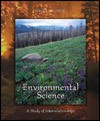 |  Environmental Science: A Study of Interrelationships, 8/e Eldon Enger,
Delta College
Bradley F. Smith,
Western Washington University
Interrelated Scientific Principles: Matter, Energy, and Environment
Chapter ObjectivesAfter reading this chapter, you should be able to:
| Understand that science is usually reliable because information is gathered in a manner that requires impartial evaluation and continuous revision. |
 |  |  | | Understand that matter is made up of atoms that have a specific subatomic structure of protons, neutrons, and electrons. |
 |  |  | | Recognize that atoms of different elements have different atomic structures and that isotopes of the same element may differ in the number of neutrons present. |
 |  |  | | Recognize that atoms may be combined and held together by chemical bonds to produce molecules. |
 |  |  | | Understand that rearranging chemical bonds results in chemical reactions and that these reactions are associated with energy changes. |
 |  |  | | Recognize that matter may be solid, liquid, or gas, depending on the amount of kinetic energy contained in the molecules. |
 |  |  | | Realize that energy can be neither created nor destroyed, but when energy is converted from one form to another, some energy is converted into a less useful form. |
 |  |  | | Understand that energy can be of different qualities. |
|



 2002 McGraw-Hill Higher Education
2002 McGraw-Hill Higher Education